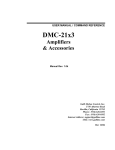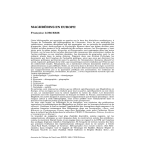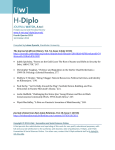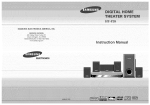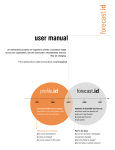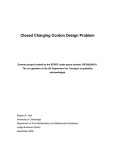Download The IMAGE Inventory: A User Guide
Transcript
Queensland Centre for Population Research The IMAGE Inventory: A User Guide Martin Bell, Aude Bernard, Elin Charles-Edwards, Dorota Kupiszewska, Marek Kupiszewski, John Stillwell, Yu Zhu, Philipp Ueffing and Alison Booth February 2015 Working Paper No 2015/01 School of Geography, Planning and Environmental Management www.gpem.uq.edu.au/qcpr Contents 1 2 Introduction .................................................................................................................................... 3 1.1 The IMAGE Project .................................................................................................................. 3 1.2 The IMAGE Inventory .............................................................................................................. 4 1.3 Outline..................................................................................................................................... 4 Impediments to cross-national comparisons of migration ............................................................. 5 2.1 Dimensions of migration ......................................................................................................... 5 2.2 Comparability of migration data ............................................................................................. 9 2.3 Type of migration data............................................................................................................ 9 2.4 Observation interval ............................................................................................................. 10 2.5 Spatial framework ................................................................................................................. 11 3 Review of internal migration data collection practice .................................................................. 11 4 Assembling the IMAGE Inventory ................................................................................................. 13 5 IMAGE Inventory: Files and Content............................................................................................. 14 6 5.1 Files ....................................................................................................................................... 14 5.2 Content ................................................................................................................................. 15 5.2.1 Inventory Overview ....................................................................................................... 15 5.2.2 Census Inventory........................................................................................................... 16 5.2.3 Register Inventory ......................................................................................................... 19 5.2.4 Survey Inventory ........................................................................................................... 20 Access to the IMAGE Inventory .................................................................................................... 21 References ............................................................................................................................................ 24 2 1 Introduction 1.1 The IMAGE Project The IMAGE project (Internal Migration Around the GlobE) is an international program of research which aims to facilitate comparisons of internal migration between countries by implementing a set of robust indicators that measure different dimensions of population mobility. Comparative analysis calls for careful consideration of differences in the nature of data collected in countries around the world (Bell et al. 2002). These differences are complicated by the limited availability of migration data, as national migration statistics are rarely available in a readily accessible format (Bell et al. 2014). Moreover, even where data are made available, formats vary widely from one country to another. Analysts also confront a number of challenges in deriving rigorous measures of migration. To address the above challenges, the IMAGE project has been developed around a number of discrete modules, including a global survey of internal migration data, the assembly of a comprehensive repository, and the development of specialised software and analytical tools, as shown in Figure 1. The first step to the IMAGE project was a global inventory of migration data collection practice in the 193 UN member states (Bell et al. 2014). Building on this inventory, a repository of internal migration data has been assembled, currently covering 135 countries. In tandem with the IMAGE Repository, a suite of analytical software, the IMAGE Studio, has been developed to facilitate the spatial analysis and modelling of internal migration by allowing the computation of a range of migration measures (Daras 2014; Stillwell et al. 2014). The IMAGE Inventory Review of internal migration data collection practice in the 193 UN member states The IMAGE Repository Global collection of population and internal migration data and GIS boundaries The IMAGE Studio Analytical software to compute internal migration measures and address key methodological issues 3 Figure 1 The IMAGE Project Framework 1.2 The IMAGE Inventory The IMAGE Inventory is a database for developed for the use by the research community interested in the study of internal migration that can be downloaded from the IMAGE website (www.gpem.uq.edu.au/qcpr-image). It is based on findings from the Internal Migration Around the GlobE project, which established an inventory of internal migration data collections for the 193 UN member States. The IMAGE Inventory covers three main sources of internal migration data: population censuses, population registers and administrative collections, and national sample surveys. It distinguishes data from the latest two UN census rounds: the 2000 round (1995-2004) and the 2010 round (2005-2014), but also includes information on a number earlier censuses, particularly for countries which have not undertaken a recent census. The Inventory was last updated in February 2015. The content of the IMAGE Inventory has been carefully selected to provide information that is thought to be of most value to migration scholars. It contains information on the types of migration data collected, the interval over which migration is measured and the spatial frameworks employed, but does not attempt to provide an exhaustive list of all data items in any individual data collection. It is important to recognise that data collection does not guarantee dissemination. For example, statistical agencies may code and release migration data at spatial scales other than those used for collection purposes. Moreover, relatively little data on internal migration is routinely made available in statistical publications or electronic form, so potential users will often need to inquire further to establish the availability of items particular data. The IMAGE Inventory essentially represents a first port of call. Nevertheless, in order to facilitate access data, the IMAGE project has also established a Repository of internal migration data, which currently holds internal migration data sets for 135 countries. Access to some data from the IMAGE Repository can be provided under certain conditions. The Inventory includes links to the IMAGE Repository. 1.3 Outline This document is a user guide to the IMAGE Inventory and is organised as follows. Section 2 summarises the main impediments to comparing migration between nations. Section 3 summarises current data collection practice in countries around the world. Section 4 discusses the strategy employed to assemble the IMAGE Inventory, with regard to the characteristics of the migration data selected and the data sources used. Section 5 introduces the content and structure of the Inventory and lists the different files available for each country and each data source. Finally, Section 6 explains how to access data from the IMAGE Inventory. 4 2 Impediments to cross-national comparisons of migration Three main issues stand in the way of effective cross-national comparisons of internal migration: the multifaceted nature of migration itself; the choice of migration indicators; and the widespread variation in the type of migration data that are collected. In any comparative analysis, a crucial first decision concerns the particular aspect of migration to be explored. Four discrete dimensions of migration can be recognised: intensity, impact, distance and connectivity (Bell et al. 2002), each of which call for somewhat different forms of data and methods of analysis. The IMAGE Repository has been assembled to facilitate comparisons on all these aspects of migration, so an understanding of the four dimensions of migration, the associated data and the migration indicators is essential to appreciate the way in which the Repository has been designed. 2.1 Dimensions of migration Four broad dimensions of internal migration can be recognised, each of which provides insights into a different aspect of migration at a particular spatial scale. These are: (1) migration intensity, which indicates the overall level or incidence of migration within a country; (2) migration impact, which captures the extent of population redistribution through migration; (3) migration distance, which indicates the distance decay associated with population movement; and (4) migration connectivity, which reveals the way migration serves to link cities and regions. Each of these dimensions can be captured using a number of statistical indicators and each of these indicators requires somewhat different forms of data. Table 1 lists in summary form the suite of 15 migration measures proposed by Bell et al. (2002) and sets out the data required for their computation. Table 1 also indicates which of these measures are generated in the IMAGE Studio. For the purposes of discussion, it is useful to identify three broad forms in which migration data are commonly available: (1) Origin-destination matrices Also described as flow matrices, these contain region-to-region migration flows in which, by convention, rows represent origins and columns represent destinations. The diagonal element of flow matrices commonly indicates the number of people who changed residence but remained in the same region at the start and end of the observation, interval but it may also contain non-movers, or a subset of people who moved between smaller zones within the region. (2) Marginal totals 5 In some cases, full origin-destination matrices are not available, but data may be provided on the aggregate number of arrivals and departures for each region. These effectively represent the marginal (row and column) totals of a full origin-destination flow matrix and are also referred to as zonal inflows and outflows. While these aggregates do not provide information on flows between specific origin-destination pairs, they can be used to generate aggregate system-wide measures of migration impact, and are also commonly available disaggregated by age and sex. It is important to know whether or not the marginal totals include or exclude flows taking place within regions. (3) National migration counts Count data comprise a single figure which indicates the total number of movers or moves between regions within a country, irrespective of origin and destination. They may also include information on changes of address that occurred within regions. They do not provide any information on the origin or destination of flows, but may be disaggregated by age and sex. Allied to these three forms of migration data are two other types of information that are required to compute some of the 15 indicators associated with the four dimensions of migration listed above. These are: (1) digital boundaries matching the regions against which migration is recorded, which are used to compute migration distances, calibrate spatial interaction models and drive the spatial aggregation facility in the IMAGE Studio, and (2) populations at risk, which are used to compute migration rates and probabilities. Table 1 shows how these data combine to generate the various migration metrics. With respect to intensity measures, for example, the Crude Migration Intensity, which is obtained by dividing the number of migrants by the population at risk, can be computed with migration data of any format, because it simply requires the aggregate number of migrants. This may be directly available in the form of a national migration count, but it can also be derived by summation from an origin-destination matrix or from marginal totals. Other intensity measures require migration data disaggregated by age, which may be available in flow matrices but are more commonly held only in the form of nationwide migration counts or marginal totals. Migration impact measures relate to individual regions so their computation requires data on inter-regional flows, which can be obtained either from origin-destination matrices or marginal totals. Distance measures are generated as Euclidian distances between the region centroids by the IMAGE Studio, but it is also possible to input a matrix of distance values assembled independently. Connectivity measures, on the other hand, require complete origin-destination flow matrices, and cannot be computed from marginal totals or from count data. 6 Table 1 shows that all measures of impact, distance and connectivity can be generated in the IMAGE Studio, with the exception of the Migration-Weighted Gini which is excluded because of the high computational load leading to long processing times. As for measures of intensity, the IMAGE Studio generates only the Crude Migration Intensity. Other measures of intensity require migration data disaggregated by age and are not computed in the IMAGE Studio. The IMAGE Studio incorporates a spatial aggregation routine which was designed to assist in generating estimates of migration intensity that are comparable between countries, and to explore the scale and pattern effects of the Modifiable Areal Unit Problem (MAUP) (Stillwell et al. 2014). Provided the requisite types and forms of information are available, the Studio can be employed to generate migration metrics for any size of migration matrix based on a set of Basic Spatial Units (BSUs). 7 CONNECTIVIY DISTANCE IMPACT INTENSITY 1 ACRONYM DIMENSIO N Table 1 Data needed for computation of migration measures in the IMAGE Studio MIGRATION MEASURE Population at risk Origin-destination matrix ● ● Measures generated in the IMAGE Studio Crude Migration Intensity CMI ● Standardised Migration Intensity SMI ● ● Gross Migraproduction Rate GMR ● ● Migration Expectancy ME ● ● Intensity at Migration Peak IMP ● ● Age at Migration Peak AMP ● ● Migration Effectiveness Index MEI Aggregate Net Migration Rate ANMR Median Distance Moved MD Mean Distance Moved MDM Distance Decay Parameter b Index of Migration Connectivity IMC ● ● Index of Migration Inequality IMI ● ● Migration-Weighted Gini MWF ● Coefficient of Variation ACV ● ● Theil Index THEIL ● ● ● ● DATA REQUIREMENT Data format 1 National count data Zonal in and outflows Total by age ● ● ● ● ● ● ● ● + digital boundaries ● + digital boundaries ● + digital boundaries ● ● ● sex-specific measures of intensity can be computed when national count data are disaggregated by sex. 8 2.2 Comparability of migration data Comparability between countries is complicated by the fact that, irrespective of data format, migration can be measured in various ways using different instruments ranging from population registers and administrative records, to censuses and surveys. As a result, significant variation exists between countries with regard to the type of migration data collected, the time interval over which migration is measured, and the spatial frameworks used. 2.3 Type of migration data Migration can be measured as an event or transition, or by reference to duration of residence. Event data are usually associated with population registers and are the most common form of internal migration data available in many European countries. Transition data measure migration by comparing place of residence at two points in time and are the type of data most commonly derived from censuses and surveys (Bell et al. 2014). Because of the way they are measured, events and transitions count different things; population registers count migrations while censuses count migrants. The difference is important because transition data fail to capture return and onwards moves that occur within the observation interval, and therefore undercount the number of migration events. There are also differences in the treatment of migration among those who are born or die in the interval, as well as in the inclusion or exclusion of immigrants (Bell and Rees 2006), and these may vary further between individual countries. The impact of these differences on overall migration intensities is small over relatively short intervals (Long and Boertlein 1990) but increases as the observation interval lengthens, and care is also needed to eliminate or control for variations in population coverage (Boden et al. 1991). Censuses around the world also commonly collect data on duration of residence in the current dwelling or locality. By filtering duration data for fixed durations of residence, it is possible to derive a surrogate estimate of the number of moves that have occurred within a given interval, comparable to the migration count data commonly derived from events or transitions. Duration of residence data are also commonly collected in association with information on previous place of residence, to generate origin-destination matrices that effectively capture each respondent’s last move. In this instance, duration of residence can be used as a filter to generate a migration flow matrix, which is broadly comparable to the conventional migration transition. However, lack of precision in the measurement of duration and ambiguity in the locality to which it applies necessitate caution in the use of these data to make cross-national comparisons (Bell et al. 2014). Table 2 summarises the principal differences between events, transitions, duration and last move data. It shows that duration and last move data essentially represent a hybrid in terms of population and migration coverage. They fail to capture multiple migration events that occur within the observation interval but capture return moves missed by transition data. 9 Despite these measurement differences national count data can be generated from event, transition, duration or last move data. Origin-destination matrices, zonal inflows and outflows can be generated from all data types, except when duration data are collected in isolation from information on previous place of residence. Table 2 Population coverage of migration flow matrices by data type Element Events Migration All moves undertaken within the interval Population Individuals in the population during the observation interval Immigrants Emigrants Born in interval Die during interval Included Included Transitions Changes of residence between the start and end of the interval Individuals alive and resident in the country at both the beginning and end of the interval. Excluded Excluded Last Move/Duration Included Excluded Included Included Excluded Excluded Most recent moves within the defined duration of residence Individuals resident in the country at the end of the interval. Included Excluded Source: Bell et al. (under review) 2.4 Observation interval Migration can be measured over a range of observation intervals, which may be of a fixed (defined) or variable length and the IMAGE Repository incorporates flow matrices pertaining to these intervals. Countries which measure migration over a fixed interval commonly use one or five years as the interval length, but other intervals ranging from two to ten years are also employed (Bell et al., 2014). Migration data measured over intervals of different length are not readily comparable due to the effects of chronic and repeat movement. The consequence is that five-year migration data are not equivalent to five times the one-year migration data, with empirical evidence showing that the ratio between one and five-year transition rates varies over time and space. While approximate conversions have been proposed, there is no straightforward analytical solution to harmonise these data (Kitsul and Philipov 1981; Rogers et al. 2003; Rogerson 1990). Data on migration events, derived from population registers and administrative collections commonly refer to a single-year interval. Some countries measure migration by comparing place of residence with place of birth, which delivers a measure of lifetime migration, and this in fact is the most common measure of internal migration collected by censuses worldwide (Bell et al. 2014). Lifetime migration data provide useful insights into the cumulative impact of migration over a population’s collective lifetime. However, because individuals have been exposed to migration for varying periods, differences in age structure prejudice comparability between 10 countries. Moreover, lifetime migration data offer limited insights into contemporary migration processes. A third approach to the collection of migration data is based on asking each person’s previous place of residence (PPR), irrespective of when the migration look place. As noted above, these data can be filtered by duration of residence, if collected, to generate a surrogate estimate that approximates a fixed interval transition. 2.5 Spatial framework Countries also vary widely in regard to the number of spatial units into which they are divided and which are used to record migration. Some countries record all changes of address, including those that take place within the same region, but for most it is the change of address that crosses regional boundaries that is recorded in the migration flow matrix described earlier. The level at spatial scale at which data are collected, as apparent on the Census form or other record, does not necessarily correspond to the level at which the data are subsequently coded or made available. At the same time, migration flow matrices for the same country, source and time interval may be made available at multiple levels of aggregation. 3 Review of internal migration data collection practice Previous sections have highlighted the diversity of ways in which migration is collected and measured. The IMAGE Inventory covers three main sources of internal migration data: population censuses, population registers and administrative collections, and national sample surveys. Five main strategies were used to identify the forms of data on internal migration collected by individual countries around the world: (1) mining of statistical organisation websites; (2) review of prior inventories and papers; (3) questionnaire survey of statistics agencies; (4) analysis of country census and survey forms; and (5) advice from an international network of scholars. The review process was conducted in 2013 for the 193 UN member states, and resulted in two main outputs. First, a synthesis and assessment of global data collections was produced (Bell et al. 2014), which provides summary statistics on the number of countries collecting migration data, the sources used, and the types of migration data collected. Second, a detailed inventory was assembled, which provides information on the types of migration data collected for each 193 UN member state. Before introducing the IMAGE Inventory, the remainder of this section provides an overview of the findings published in Bell et al. (2014). The IMAGE survey shows that most countries rely on population censuses to measure internal migration (158 countries). As shown in Table 3, nationally representative surveys are also widely used (110 countries), while population registers and administrative data 11 feature in 50 countries and are the dominant collection practice in Europe. Most countries (109) draw migration statistics from multiple sources. Table 3 Countries collecting internal migration data since 1995 by region and source Register Survey Multiple sources Total countries collecting data Total countries Africa 43 0 Asia 37 15 Europe 31 32 Latin America 32 0 Northern America 2 2 Oceania 13 1 Total 158 50 Source: IMAGE Inventory; see Bell et al. (2014) 38 24 32 12 2 2 110 31 27 34 12 2 3 109 50 41 41 32 2 13 179 54 47 43 33 2 14 193 Region Census Among countries using census-based statistics, lifetime migration based on region of birth is the most common migration measure worldwide (122 countries), but many countries also measure migration by reference to last place of residence. A total of 52 countries measure migration over a five-year interval, whereas 29 countries use a one-year interval. A total of 71 countries collect data on duration of residence at their census, often in association with place of last residence. Table 4 Countries collecting internal migration data in the 2000 UN Census round by region Type of Data Observation Period Other One Five year fixed Lifetime year interval Africa 9 8 8 29 Asia 2 13 8 27 Europe 13 4 12 25 Latin America 2 17 2 29 Northern America 1 2 0 2 Oceania 2 8 2 10 Total 29 52 32 122 Source: IMAGE Inventory; see Bell et al. (2014) Region Last move 13 18 10 12 0 2 55 Duration of residence 17 24 12 13 0 5 71 Total countries collecting data 32 35 31 29 2 13 142 The review of two large-scale survey programs in developing countries − the USAID’s Demographic and Health Surveys (DHS) and the World Bank’s Living Standards Measurement Study (LSMS) − showed that duration of current residence is also commonly asked, together with place of previous residence. Duration of residence is available for a total of 60 countries in the DHS and 14 countries in the LSMS. Among developed countries, the review of the European Union’s Labour Force Surveys and the American Community 12 Survey showed that most countries utilising surveys measure migration by reference to place of residence one year previously. Table 5 Countries collecting internal migration data by survey(s) by region Region Demographic and Health Survey Africa 38 Asia 18 Europe 3 Latin America and Caribbean 10 Northern America 0 Oceania 1 Total 70 Source: IMAGE Inventory; see Bell et al. (2014) Living Standards Measurement Survey 2 8 5 4 0 1 20 Other national Survey All surveys 0 8 26 0 2 0 36 38 24 32 12 2 2 110 Population registers and administrative records capture migration as an event (Rees et al. 2000), although it is feasible to generate transition data from comparison of registers at two points in time. The IMAGE inventory identified 50 nations producing migration statistics using administrative records or population registers, 32 of them being in Europe. 4 Assembling the IMAGE Inventory To facilitate access to the findings of this review, a detailed inventory was assembled to provide information on the types of migration data collected for each of 193 UN member states. It is important to note that not all data collected are subsequently released and that the IMAGE Inventory provides information on what is theoretically available. However, the Inventory also contains information on register-based migration statistics known to be available. The IMAGE Inventory contains information on the types of migration data collected, the interval over which migration is measured and the spatial frameworks employed, but does not attempt to provide an exhaustive list of all data items in any individual data collection. This limitation is particularly true in the case of surveys, since many provide information such as detailed migration histories which cannot be adequately summarised here. While some information items, such as the types of migration data collected, the interval over which migration is measured, and the spatial frameworks are common to censuses, registers and surveys, others are specific to particular data sources. For example, information on migrant characteristics, including age and sex, are reported only for registers whereas reasons for moving are reported only for surveys. 13 The IMAGE Inventory endeavours to provide a comprehensive global collection of internal migration practices. While it provides complete coverage of censuses, population registers and administrative collections, a full inventory of migration surveys is out of reach. The inventory focuses mainly on surveys conducted since 1995 that potentially facilitate crossnational comparison, such as the USAID's Demographic and Health Survey, the World Bank's Living Standards Measurement Study and the European Union Labour Force Surveys. 5 IMAGE Inventory: Files and Content 5.1 Files The three main sources of migration data - population censuses, population registers and administrative collections, and national sample surveys – vary markedly in the way they measure migration. Because differences in the way migration is measured ultimately shapes the utility of the data (Bell et al. 2014), the IMAGE Inventory has been structured around three discrete components, one per data source. A fourth component provides a summary of the findings across the three data sources and is intended to serve as a readily accessible guide to the types of data available in each country. Reflecting this structure, the IMAGE Inventory takes the form of four Excel spreadsheets in which rows present unique records, each pertaining to a particular country for a particular year, and columns sets out the particular feature of the data collected for each country (e.g. observation interval). These four Excel components of the Inventory are as follows: (1) Inventory Overview The overview file indicates whether a census, register or national survey is conducted in each country and whether these instruments are used to collected any form of migration data. This file enables analysts to identify whether migration data are collected in their country of interest, and from which type of data collection technique. Note that this file does not contain any information on the type of migration data collected. (2) Census Catalogue This file provides information on migration data collected at the census in each country. It contains fields which indicate, inter alia, the observation interval and spatial scale at which the data were collected, as well as general information about the census, including the date it was held. (3) Register Catalogue This file indicates whether population registers or administrative data collections are maintained in each country and contains information on the types and forms of migration data are known to be made available. It also indicates whether information is 14 available on migrants characteristic such age and sex, and general information on the data source, including the name and purpose and coverage. (4) Survey Catalogue This file provides information on migration data collected in national surveys. It contains information, inter alia, on the observation interval and spatial scale used and indicates whether reasons for moving are collected. It also provides general information on the survey population and sample size. 5.2 Content This section describes separately for each file the information held in the Inventory and indicates how each record is displayed and organised. 5.2.1 Inventory Overview For ease of reading, information on censuses, registers and surveys are held under different tabs in the Excel spreadsheet. For each record, 4 fields related to censuses, 3 fields to registers and four fields to surveys. Table 7 names and describes the contents of each field and the values it can assume. Most registers have been continuously maintained for long period of times and allow production of migration statistics annually, so no particular year has been reported for registers. This is in contrast with censuses and surveys, which are typically held in a particular year. While registers and administrative sources typically collect information on place of residence, it does not guarantee that migration data are subsequently made available. For that reason, the migration data field specifies whether migration data from registers are known to available, whereas for censuses and surveys it indicates whether migration data are collected. Users can sort the data by country, or any other field of their choice, but cannot edit the content of the spreadsheet. Table 7 Fields in the IMAGE Overview Register Census Tab Field Description Values 1 Country Country for which the information is held - Country name 2 Census Was a census held at this census round? - Yes No Do not know 3 Census year Year the census was held - Year Yes No Do not know Not applicable 4 Migration data Are migration data collected at the census? - 1 Country Country for which the information is held - Country name Register Are internal migration data collected by a register or administrative dataset? - Yes No Do not know 2 15 Survey 3 5.2.2 Register name Name of the register or administrative collection - Name of the register or administrative records Not applicable 1 Country Country for which the information is held - Country name 2 Survey name Name of the survey - Survey name 3 Year Year the survey was held - Year 4 Migration data Are internal migration data collected in the survey? - Yes No Do not know ( Census Catalogue For each record, the key features of the migration data are set out in a series of 24 discrete fields (field 4 to 27). An additional 7 fields (fields 1 to 3 and field 28 to 31) present the characteristics of the census, and one field indicates whether the collected data is available in the IMAGE Repository (field 31). Table 8 names and describes the contents of each field and the values it can assume. Because migration can be measured over different intervals, the Inventory specifies whether migration data are measured over one-year interval (field 4 to 7) or a five-year interval (fields 8 to 11), which are the most common fixed intervals. It also indicates whether another fixed interval is used (field 12), and if so it specifies the length of the interval in field 13. Migration data collected without reference to a particular interval are listed in field 21 to 24. Data on duration of residence and place of birth are also reported in fields 17 to 20 and 25 to 27, respectively. Some fields are specific to a particular type of migration data, whereas others are duplicated across all migration measures. While most fields are self-explanatory some elaboration in regard to particular fields may be useful. All changes of address This field indicates wether information on all changes of address is collected in relation to place of previous residence. It is reported for each observation interval (one- and five- year interval, other fixed interval, and no interval) and for duration of residence. Data on all changes of address, irrespective of distance and regional boundary crossing, enable analysts to compute migration measures that are directly comparable across countries (Bell et al. 2002; Long et al. 1988). It is important to note that while all changes of address may have been collected for migration measured over a particular interval, it may well not be case for another interval. For instance, at its 2010 census Japan collected duration of residence for all changes of address, but collected town or village of residence five years ago. Spatial units This field specifies the name of the smallest spatial unit used to collect place of previous residence. It is reported for one- and five- year interval, other fixed interval, and no interval data duration of residence and place of birth. For the same record, the smallest spatial unit 16 used to collect a particular type of migration may differ to that used to collect another type of migration. For instance, at its 2006 census, Canada collected municipality of residence one and five years ago, but collected region of birth. Number of spatial units for OD matrix Because data collection does not guarantee dissemination, this field indicates the smallest spatial unit for which an origin-destination matrix is known to be available and specifies the number of spatial units. This field is available for place of previous residence one and five years ago, duration of residence and place of birth. In most instances, the spatial unit used to disseminate flow matrices will be different from the smallest unit used for collection purposes. Duration question Important variations exist between countries in the way data on duration of residence is collected. This field specifies if duration of residence is collected based on year of arrival, year and moth of arrival, or period of residence in years, in years and months, or in predefined duration intervals. Duration of residence derived from date of arrival and period of residence are not directly comparable, and care is therefore needed when comparing duration of residence across countries or over time. Previous place of residence – no interval This field indicates whether information on previous place of residence, irrespective of when migration took place, is collected. As noted earlier, these data can be filtered by duration of residence (field 17) to generate a surrogate estimate that approximates fixed interval transitions. Table 8 Fields in the Census Catalogue One-year interval Migration data Background information Field Description Country for which the information is held Values - Country name - Year - Yes No Do not know Yes No Do not know Yes No Do not know Not applicable 1 Country 2 Census year Year the census was held 3 Migration data Are migration data collected at the census? 4 Previous place of Residence - 1 year Is place of residence a year ago collected? 5 All changes of address - 1 year Is information on all changes of address one year ago collected? 17 Five-year interval Other fixed interval Duration of residence 6 Spatial units - 1 year Name of the smallest spatial unit for which place of residence one year ago is collected 7 Spatial units for OD matrix - 1 year Smallest spatial unit for which an origin-destination matrix is available 8 Previous place of Residence – 5 years Is place of residence five years ago collected? 9 All changes of address -5 years Is information on all changes of address five years ago collected? 10 Spatial units - 5 years Name of the smallest spatial unit for which place of residence five years ago is collected 11 Number of spatial units for OD matrix - 5 years Smallest spatial unit for which an origin-destination matrix is available 12 Previous place of residence – other Is place of residence at another interval collected? 13 Previous place of residence interval – other Interval used to collect previous place of residence 14 All changes of addressother Is information on all changes of address for this interval collected? 15 Spatial units - other Name of the smallest spatial unit for which place of residence for this interval is collected 16 Number of spatial units for OD matrix - other Smallest spatial unit for which an origin-destination matrix is available 17 Duration of residence Is duration of residence collected? - 18 Duration question How is duration of residence collected? 19 All changes of address duration Is information on all changes of address collected? 20 Spatial units – duration Name of the smallest spatial unit for which place of residence is collected - Name of the spatial unit Do not know Not applicable Number of spatial units Do not know Not applicable Yes No Do not know Yes No Do not know Not applicable Name of the spatial unit Do not know Not applicable Number of spatial units Do not know Not applicable Yes No Do not know Interval Do not know Not applicable Yes No Do not know Not applicable Name of the spatial unit Do not know Not applicable Number of spatial units Do not know Not applicable Yes No Do not know Duration in years and months (DYM) Duration n years (DY) Pre-defined duration intervals (DOI) Year and month of arrival (YMOA) Year of arrival (YOA) Do not know Not applicable Yes No Do not know Not applicable Name of the spatial unit Do not know Not applicable 18 No interval Place of birth General information 5.2.3 21 Previous place of residence- no interval Is information on previous place of residence without reference to any date collected? 22 All changes of address -previous residence Is information on all changes of address collected? 23 Spatial units – previous residence Name of the smallest spatial unit for which place of residence is collected 24 Number of zonal units for OD matrix – previous residence Smallest spatial unit for which an origin-destination matrix is available 25 Birth place Is place of birth collected? 26 Spatial units – birth place Name of the smallest spatial unit for which place of birth is collected 27 Number of zonal units for OD matrix – birth place Smallest spatial unit for which an origin-destination matrix is available 28 Source Source of the information 29 Latest census Is this the latest census? 30 Counted In Census Date the census was held 31 IMAGE Repository Is migration data from this census held in the IMAGE Repository? - Yes No Do not know Yes No Do not know Not applicable Name of the spatial unit Do not know Not applicable Number of spatial units Do not know Not applicable Yes No Do not know Name of the spatial unit Do not know Not applicable Number of spatial units Do not know Not applicable - source - Yes No Do not know Date Do not know - Yes No Register Catalogue For each record, 5 fields specify the features of the administrative collection and 34 fields describe the characteristics of the migration data known to be available. Of the 53 countries maintaining a population register or administrative datasets, 33 are known to make migration statistics available. Table 9 names and describes the contents of each field and the values it can assume. As noted in Section 2, each of the 15 migration measures call for specific data format (Bell et al. 2002), so the data format field indicates wether migration data are held in the form of origin-destination flow matrices, marginal totals capturing total arrivals and departures, or national counts of all moves. Some countries publish registerbased migration statistics using a range of formats (national count, marginal totals or origindestination matrix) and spatial units for different years. For example, Bulgaria releases both origin-destination matrix between and marginal totals between 28 administrative units and marginal totals for 264 administrative units. Because migration data can be made available in a range of formats, fields 6 to 14 are replicated 4 times. 19 Table 9 Fields in the Register Catalogue Migration data available Background Information Field 1 Country 2 Register 3 Register name Name of the register or administrative collection Values - Country name - Yes No Do not know Name of the register or administrative records Do not know Population register Administrative dataset Do not know Population coverage Do not know Calendar year Other (specify) Do not know Yes No Do not know 4 Collection type Type of data collection 5 Population coverage Persons included in the register 6 Observation interval Interval over which migration data is collected 7 All changes of address Is information on all changes of address available? 8 Spatial unit name Name of the smallest spatial unit for which place of residence is available - Name of the spatial unit 9 Spatial unit number Smallest spatial unit (number) for which place of residence is available - Number of spatial units 10 Data format Format in which migration data is available 11 Age Is age available? - Count data Marginal totals Flow matrix Yes (1) No (0) Do not know (DK) 12 Age groups Groups in which age is available - Age groups 13 Sex Is sex available? - Yes (1) No (0) Do not know (DK) 14 Years Years for which the data are available - Years ... ... 39 5.2.4 Description Country for which the information is held Are internal migration data collected by a register or administrative dataset? IMAGE Repository ... Is migration data from this register held in the IMAGE Repository? ... - Yes No Survey Catalogue For each record, 30 fields specify the features of the migration data available and provide general information about the survey. Most fields are similar to those in the Census Inventory. Two fields are specific to surveys: reasons for moving (field 22) and movements between rural and urban areas (field 24). Table 10 names and describes the contents of each field and the values it can assume. 20 Table 10 Fields in the Survey Catalogue Migration data Background information Field Description Country for which the information is held 1 Country 2 Survey Name Name of the survey 3 Year Year the survey was held 4 Migration data Is migration data collected in this survey? 5 Previous place of residence Is place of residence at a fixed interval collected? 6 Fixed interval Interval used to collect previous place of residence 7 All changes of addressfixed interval Is information on all changes of address available? 8 Spatial unit - fixed interval Name of the smallest spatial unit for which place of previous residence is collected 9 Previous place Residence – other Is place of residence at another fixed interval collected? 10 Other fixed interval Interval used to collect previous place of residence 11 All changes of addressother fixed interval Is information on all changes of address available? 12 Spatial unit - other fixed interval Name of the smallest spatial unit for which place of previous residence is collected 13 Duration of residence Is duration of residence collected? 14 All changes of address duration Is information on all changes of address collected? 15 Spatial unit - duration 16 Previous residence- no interval 17 All changes of address -previous residence Is information on all changes of address collected? 18 spatial unit – previous residence 19 Birth place Values - Country name - Name No known survey Year Do not known Not applicable Yes No Do not know Yes No Do not know Interval as specified in the census form Yes No Do not know - Name of the spatial unit Do not know - Yes No Do not know Interval as specified in the census form Yes No Do not know - Name of the spatial unit Do not know - Yes No Do not know Yes No Do not know - Name of the spatial unit Do not know - Yes No Do not know Yes No Do not know Name of the smallest spatial unit for which place of previous residence is collected - Name of the spatial unit Do not know Is place of birth collected? - Yes No Do not know Name of the smallest spatial unit for which duration of residence is collected Is information on previous place of residence without reference to any date collected? 21 General Information 20 Spatial units – birth place Name of the smallest spatial unit for which place of birth is collected - Name of the spatial unit Do not know 21 Number spatial unit – birth place Number of smallest spatial units for which place of birth is collected 22 Reasons for moving Are reasons for moving collected? - Name of the spatial unit Do not know Yes No Do not know 23 Code frame - code frame 24 Rural-urban movement - Yes Do not know 25 Additional waves Are there additional waves to the survey? 26 Survey population Population studied in the survey - Yes No Do not know Population Do not know 27 Sample Size of the survey sample - Sample size Do not know 28 Source Source of the information - Source 29 Comments Additional information on migration data collected - comment 30 IMAGE Repository Is migration data from this survey held in the IMAGE Repository? - Yes No What is the code frame used to collect reasons for moving? Is any information on movement between rural and urban areas collected? 6 Access to the IMAGE Inventory The IMAGE Inventory can be accessed directly on the IMAGE Project webpage (www.gpem.uq.edu.au/qcpr-image). The four components of the Inventory (Inventory Overview, Census Inventory, Register Inventory and Survey Inventory) can be downloaded as separate Excel documents. These are being made freely available to the research community, but we ask that publications and reports which drawn on or utilise data from these workbooks to acknowledge the IMAGE Inventory by citing the user guide as follows: Bell, M., Bernard, A., Ueffing, P., and Charles-Edwards E. (2015), The IMAGE Inventory: A User Guide. Queensland Centre for Population Research Working Paper Series, No 2015/01, The University of Queensland, www.gpem.uq.edu.au/qcpr-image Notwithstanding the best efforts of the IMAGE team in assembling the Inventory, it is inevitable that some inaccuracies and omissions may occur. The information contained in the spreadsheets is provided in good faith but the IMAGE team and the University of Queensland accept no responsibility for any decisions taken or not taken on the basis of the 22 information provided in the Inventory. The IMAGE team would be grateful for any comments on the Inventory and notification of any corrections, which should be emailed to [email protected]. In order to facilitate access data, the IMAGE project has also established a Repository of internal migration data, which currently holds internal migration data sets for 135 countries. A guide to the IMAGE Repository (http://www.gpem.uq.edu.au/qcprdocs/ImageRepositoryUserGuide.pdf) and a catalogue of data holdings can also be found on the IMAGE Project webpage (www.gpem.uq.edu.au/qcpr-image). Access to some data from the IMAGE Repository can be provided under certain conditions. 23 References Bell, Martin and Rees, P (2006), 'Comparing migration in Britain and Australia: harmonisation through use of age-time plans', Environment and Planning A, 38 (50), 959-88. Bell, Martin, et al. (2014), 'Internal Migration Data Around the World: Assessing Contemporary Practice', Population, Space and Place. --- (under review), 'Internal migration and development: comparing migration intensities around the world', Population, Space and Place Bell, Martin, et al. (2002), 'Cross-national comparison of internal migration: issues and measures', Journal of the Royal Statistical Society: Series A (Statistics in Society), 165 (3), 435-64. Boden, P, Stillwell, J, and Rees, P (1991), Internal migration projection in England: the OPCS/DOE model examined (Migration Models: Macro and Micro Approaches; London: Belhaven). Daras, K. (2014), 'IMAGE Studio 1.1 User Manual', Working Paper (University of Leeds). Kitsul, P and Philipov, D (1981), 'The One-Year-Five-Year Migration Problem', Advances in Multiregional Demography, Research Report 81-6 (Laxenburg, Austria: International Institute for Applied Systems Analysis). Long, L. and Boertlein, C.G. (1990), 'Comparing migration measures having different intervals', Current Population Reports, Series P-23 (Washington DC: US Bureau of Census), 1-11. Long, L., Tucker, C.J., and Urton, W.L. (1988), 'Migration distances: An international comparison', Demography, 25 (4), 633-40. Rees, Philip, et al. (2000), 'Problems and solutions in the measurement of migration intensities: Australia and Britain compared', Population Studies, 54 (2), 207-22. Rogers, A, Raymer, J, and Newbold, K B (2003), 'Reconciling and translating migration data collected over time intervals of differing widths', The Annals of Regional Science, 37 (4), 581-601. Rogerson, P.A. (1990), 'Migration analysis using data with time intervals of differing widths', Papers of the Regional Science Association, 68, 97-106. Stillwell, John, et al. (2014), 'The IMAGE studio: a tool for internal migration analysis and modelling', Applied Spatial Analysis and Policy, 7 (1), 5-23. 24

























